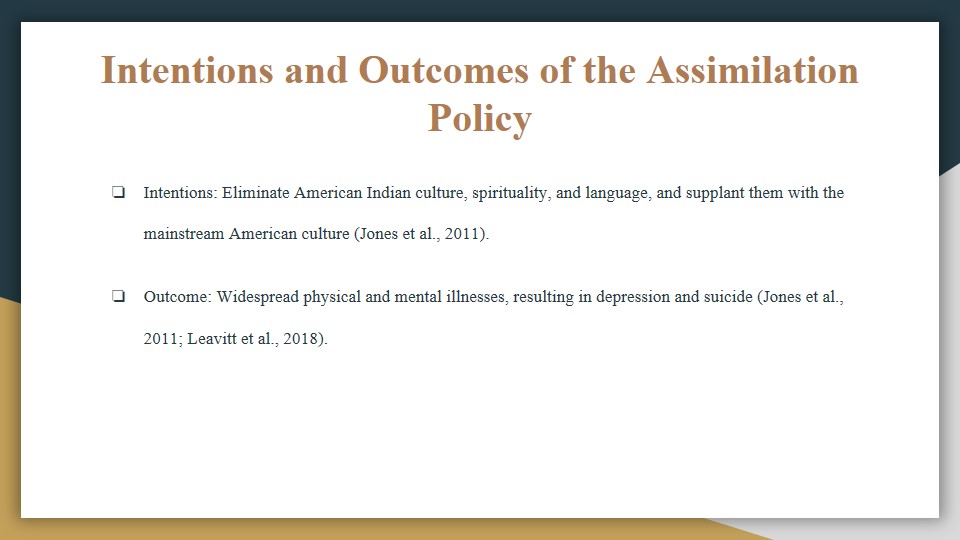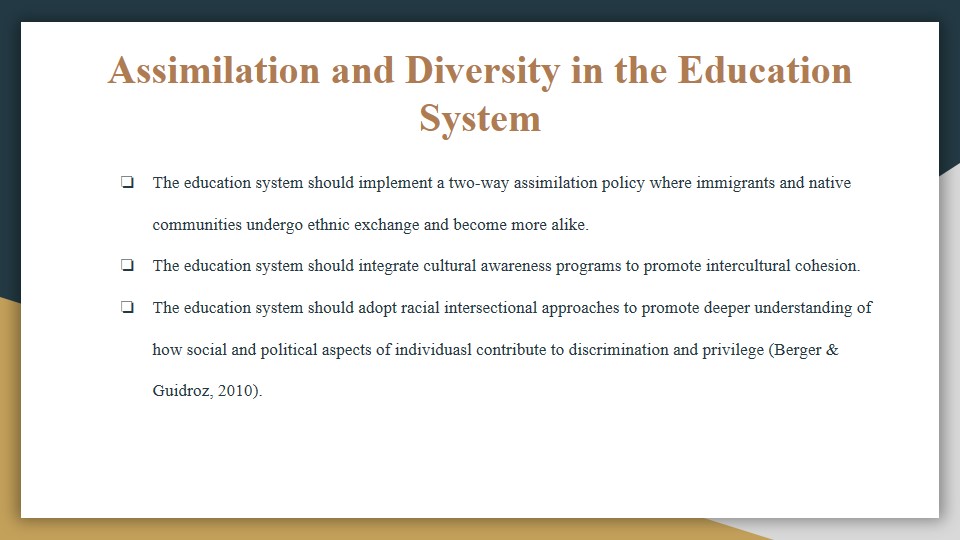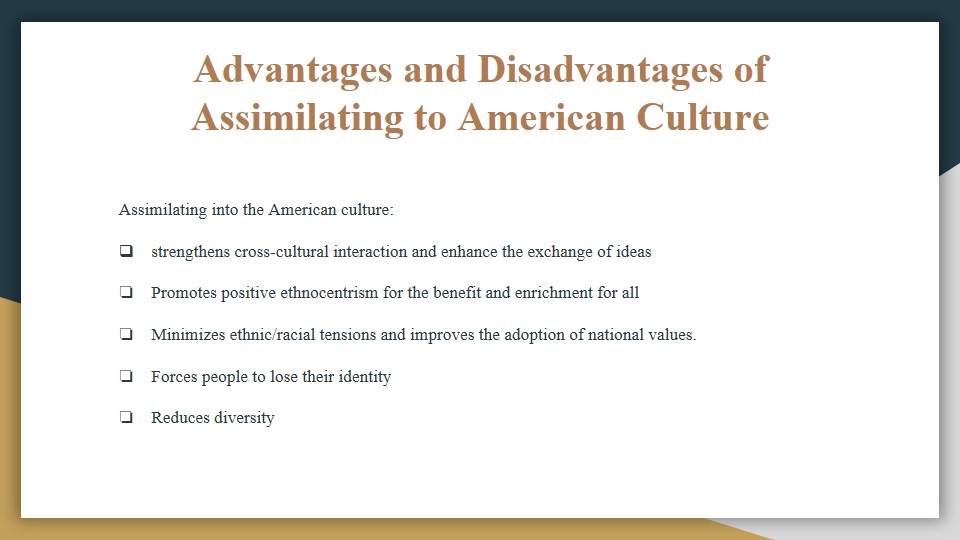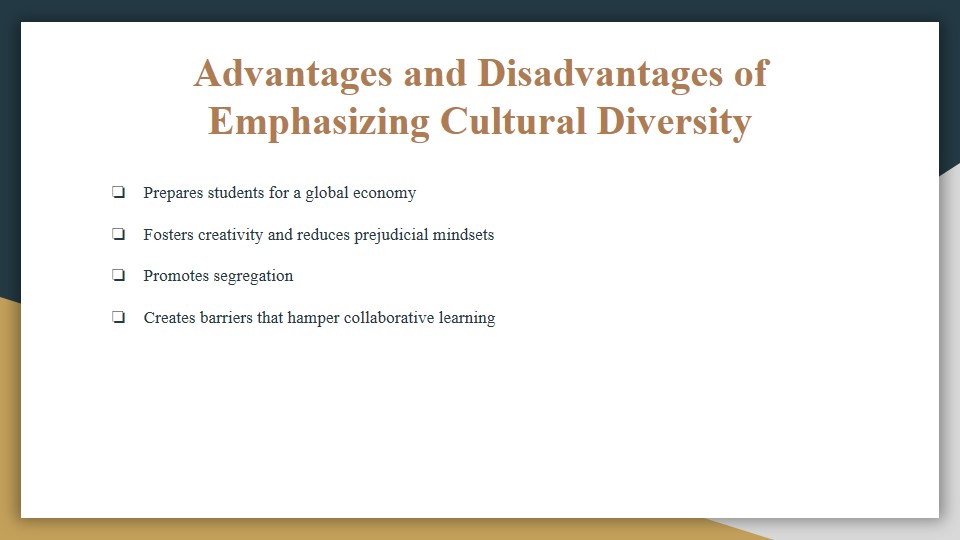Intentions and Outcomes of the Assimilation Policy
- Intentions: Eliminate American Indian culture, spirituality, and language, and supplant them with the mainstream American culture (Jones et al., 2011).
- Outcome: Widespread physical and mental illnesses, resulting in depression and suicide (Jones et al., 2011; Leavitt et al., 2018).
The Assimilation policy was intended to facilitate the complete destruction of the American Indian ways of life, language, and spirituality. The culture would be replaced with the dominant western Anglo-American norms and values.
Many students and their families suffered serious physical and mental illnesses. Additionally, the American Indians had to live with the imposed perception that they were inferior to the Americans. Some of these effects are evident today as American Indians are twice as likely to commit suicide compared to Americans (Leavitt et al., 2018).

Assimilation and Diversity in the Education System
- The education system should implement a two-way assimilation policy where immigrants and native communities undergo ethnic exchange and become more alike.
- The education system should integrate cultural awareness programs to promote intercultural cohesion.
- The education system should adopt racial intersectional approaches to promote deeper understanding of how social and political aspects of individuasl contribute to discrimination and privilege (Berger & Guidroz, 2010).
Although the world is increasingly becoming globalized, the education system should adopt a multi-pronged approach toward assimilation. The ethnic aspects of individuals should not be stripped away. However, people should be encouraged to adopt the American culture without forgetting their roots.
The education system should be as diverse as possible and reflect the growing cultural diversity.
Integrating racial intersectional approaches can enhance the understanding of an individual’s social and political perspectives contribute to discrimination and privilege. The comprehension of the prejudices that people face is critical in the formulation of solutions (Berger & Guidroz, 2010).

Advantages and Disadvantages of Assimilating to American Culture
Assimilating into the American culture:
- Strengthens cross-cultural interaction and enhance the exchange of ideas.
- Promotes positive ethnocentrism for the benefit and enrichment for all.
- Minimizes ethnic/racial tensions and improves the adoption of national values.
- Forces people to lose their identity.
- Reduces diversity.
Assimilating into the American culture will promote cross-cultural exchanges where people from diverse ethnicities can interact and exchange ideas. The conception helps people to develop holistic worldly views. Additionally, the assimilation will foster positive ethnocentrism which will minimize the racial tensions.
However, assimilation reduces diversity, promotes narrow world views, and forces people to lose their identity.

Advantages and Disadvantages of Emphasizing Cultural Diversity
- Prepares students for a global economy.
- Fosters creativity and reduces prejudicial mindsets.
- Promotes segregation.
- Creates barriers that hamper collaborative learning.
Emphasizing cultural diversity in classroom prepares students to the highly globalized economy.
The idea fosters creativity and minimizes prejudices.
A culturally diverse education system promotes segregation and establishes barriers that limit collaborative learning.

References
Berger, M. T., & Guidroz, K. (Eds.). (2010). Intersectional approach : Transforming the academy through race, class, and gender.
Jones, J. L., Bosworth, D. A., Lonetree, A., and Ziibiwing Center of Anishinabe Culture & Lifeways. (2011). American Indian boarding schools. An exploration of global ethnic & cultural cleansing. Ziibiwing Center of Anishinabe Culture & Lifeways.
Leavitt, R., Ertl, A., Sheats, K., Petrosky, E., Ivey-Stephenson, A., & Fowler, K. (2018). Suicides among American Indian/Alaska Natives — National Violent Death Reporting System, 18 States, 2003–2014. MMWR. Morbidity And Mortality Weekly Report, 67(8), 237-242. Web.